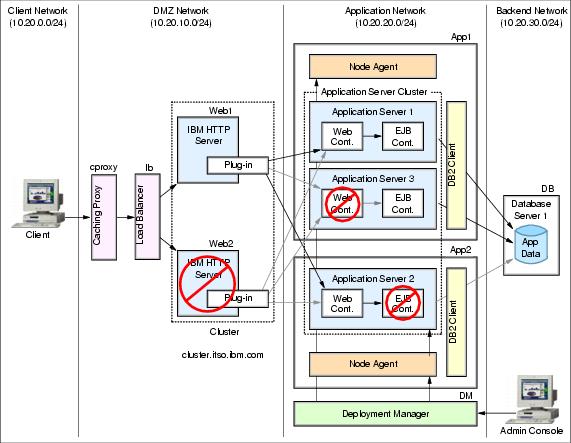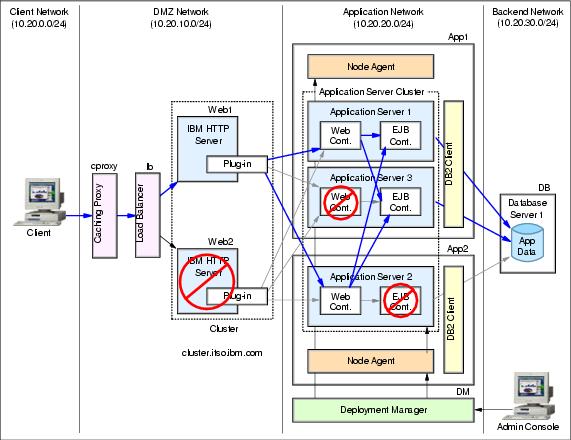Topologies and high availability
In order to select the most appropriate topology, it is important to understand how WebSphere provides high availability for the Web container and EJB container. Therefore, we examine the three failure situations shown in Figure 3-15: HTTP server, Web container, and EJB container.

Figure 3-15 Failure situations
In normal operation, the HTTP requests are forwarded to one of the clustered machines (web1 or web2) acting as HTTP servers. If the requests should be served by WebSphere, the plug-in uses HTTP transport to route requests to the appservers on system app1 or app2. The Web applications are deployed on member application servers in the WEBcluster (web1a and web1b on app1, and web2 on app2).
In case of a failure of one of these appservers, or if the application server is not active, the plug-in redirects the requests to the available members in the same cluster (WEBcluster). The requests will be sent using HTTP, either to the same machine or to a separate machine. For plug-in workload management and failover details, refer to Chapter 5, Plug-in workload management and failover.
The same applies to EJB containers. We configured a cluster consisting of applications servers in EJBcluster (EJB1a and EJB1b on system app1, and EJB2 on app2). If an EJB appserver is not available, requests are directed to the available EJB application server in the EJBcluster. Chapter 6, EJB workload management provides further details on EJB workload management.
If an HTTP server fails, Load Balancer redirects HTTP requests to the available HTTP servers on the cluster. Figure 3-16 shows how requests are routed around the failed Web server and appservers in our sample topology.
Note Failure of Deployment Manager does not interrupt the managed servers. The Deployment Manager node stores the master configuration repository and every managed server stores only the appropriate subset of the master configuration. Therefore, we do recommend maintaining the master configuration repository on a shared file server. The objective is to recover the configuration data, in exceptional cases such as a complete failure of the machine running Deployment Manager. See the redbook IBM WebSphere Version 5.0 System Management and Configuration, SG24-6195 for more information about the configuration repository. |

Figure 3-16 Failover behavior
WebSphere is a trademark of the IBM Corporation in the United States, other countries, or both.
IBM is a trademark of the IBM Corporation in the United States, other countries, or both.